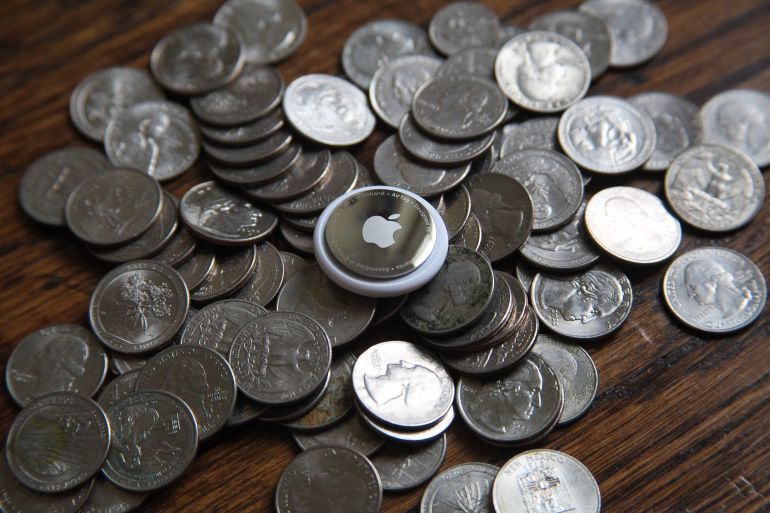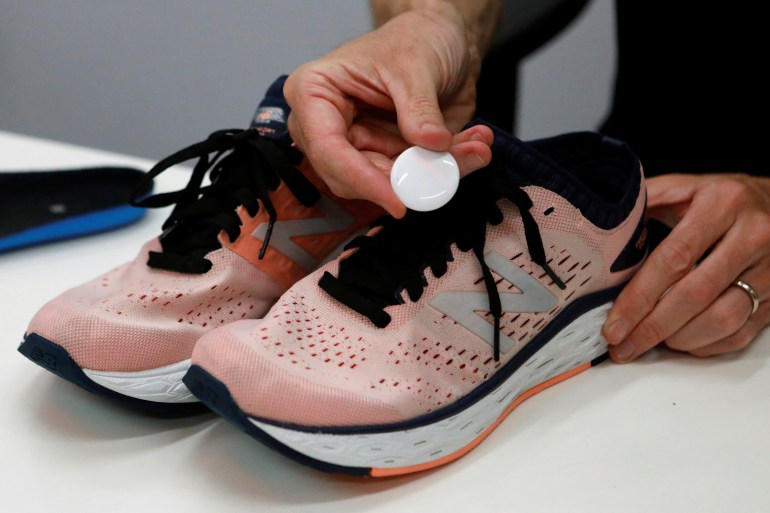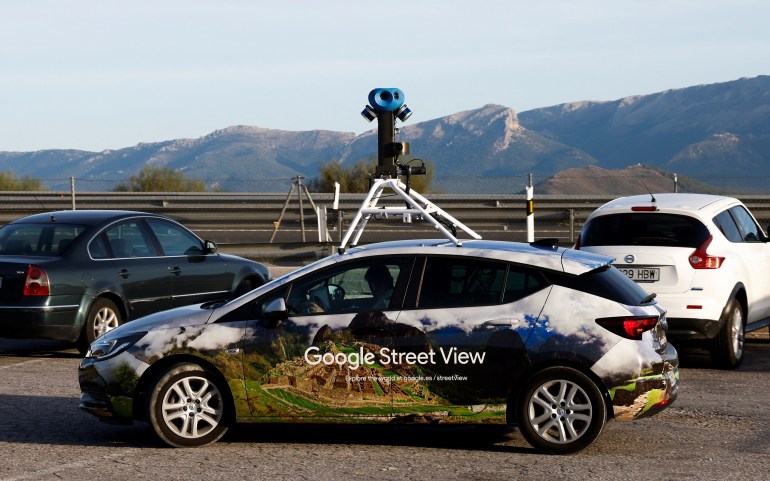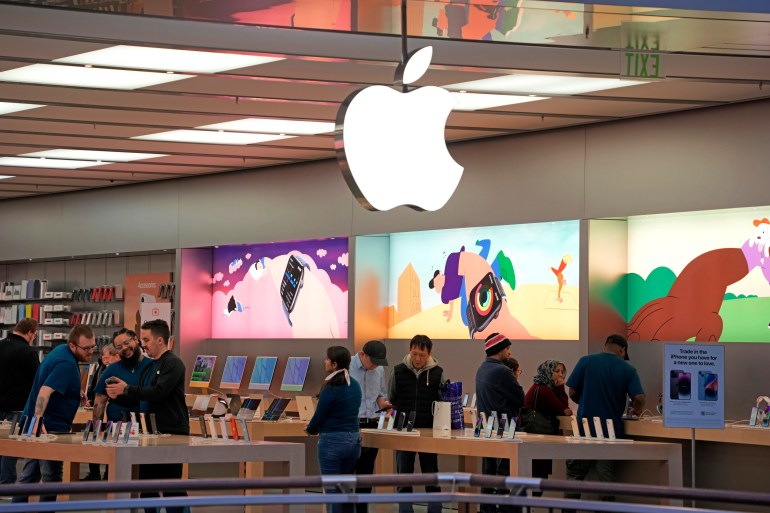US lawsuit takes aim at ‘weapon of choice’ for stalkers
Cheriena Ben is among plaintiffs in a US class-action lawsuit alleging Apple AirTags facilitate stalking and violence.

San Francisco, California – With the nearest bridge under construction, Cheriena Ben had to take the long way home: down a long, winding road through an isolated stretch of central Mississippi, not far from the Pearl River.
Ben was travelling with her pregnant cousin, who was coming to stay for a couple of nights after a row with the father-to-be.
Keep reading
list of 3 itemsHarvey Weinstein: 16 years for rape, sexual assault in LA trial
‘I ask for justice’: Haiti faces sexual violence crisis
But when the two women arrived at the house, Ben’s cousin pulled her aside. “You’ve got an AirTag on you,” she warned, showing Ben the alerts popping up on her phone. Ben, though, had never heard of an AirTag. She did not know what its presence could mean.
Small, silver and roughly the size of a large coin, AirTags are a Bluetooth tracking device that critics accuse of facilitating stalking and other violations of privacy.
Ben is now one of several women taking part in a class-action lawsuit in the United States against its maker, the tech giant Apple, for what they consider negligence in the product’s design and availability.
“With a price point of just $29, it has become the weapon of choice of stalkers and abusers,” says the civil suit, filed in the United States District Court of Northern California. The complaint calls for damages to be awarded, as well as for Apple to correct its “practice of releasing an unreasonably dangerous product into the stream of commerce”.

‘So rushed’
Apple said it could not comment on the active litigation, but it did refer Al Jazeera to a statement on its website that condemns “in the strongest possible terms any malicious use” of its products.
For Ben, it all started in late 2021, when she met a man in a bar. “He kind of blew me off,” Ben remembered. But then he reached out to her afterward on a messaging app, and they bumped into each other again at a community Christmas tree lighting ceremony.
A 37-year-old mother of two, Ben describes herself as a private person. She had not been on a date in years, much less embarked on a relationship. After all, for much of her adult life — 15 years — she had been with a single man: the father of her children.
But this new acquaintance seemed to move quickly. “He started to call me girlfriend early on to other people,” Ben recalled. Her inbox grew crowded with his queries: How was your day? Do you want to go to dinner? Do you want to do something else?
“It was just so rushed,” Ben said. She remembers telling him that their relationship was moving way too fast. But it did not cross her mind to question why his iPhone kept getting alerts every time she was around, dinging and buzzing during their time together.
By April of last year, Ben had started to pull away from the relationship. And she could tell the man was not pleased. “He was really aggravated when I was distancing myself,” she said.
The idea that he might stalk her, however, was not a possibility Ben had considered. Her pregnant cousin had to help explain how an AirTag might be allowing the man to track her every move.

Millions stalked in US
Erica Olsen, the senior director of the Safety Net Project at the National Network to End Domestic Violence (NNEDV), has spent more than 16 years investigating how technology has transformed sexual and domestic violence.
“When I first started doing this work, I got a lot of questions like, ‘What do you mean? What is the intersection of technology and abuse?’” Olsen told Al Jazeera in a recent interview.
But Olsen has seen a transformation over her tenure in how US society conceives of stalking. “Most stalking laws included an element of physical stalking, of physical proximity to the person. And technology changed that,” she explained.
Now, the US Department of Justice takes a wider view of stalking: No longer does a perpetrator have to be physically tailing a victim. Stalking can be committed via technology, whether through repeated unwanted messages or monitoring a victim’s activities.
Overall, the Justice Department estimates that 3.4 million Americans were stalked in 2019. Of that total, 1.1 million cases involved technology, with 394,000 people reporting that their whereabouts had been tracked through apps or devices.
The way Olsen sees it, though, the problem didn’t start with AirTags. She remembers how the spread of caller identification on telephones sparked concerns even back in the 1990s.
“When caller ID first came out, it was connected landlines, and you could search that and you could locate somebody based on that number, right down to a house,” she said.

But a turning point came when the search engine Google unveiled its Street View technology in 2007, allowing users to use 360-degree imagery to explore maps around the world.
Google realised that its new feature could be used to identify confidential locations like domestic violence shelters, where abuse survivors often flee for safety, so it sought input from the NNEDV, where Olsen worked.
“That was one of the first big connections with a company where we partnered to work together to find solutions,” she said. The NNEDV has since collaborated with other high-profile tech companies, including Apple, Amazon and Meta.
Awareness of privacy and safety issues has increased among tech manufacturers, Olsen said. But the opposite has been true, too: “We have also seen things clearly rushed to the market to launch, when they’re not the safest.”
“So many technologies are designed with an assumption that those you share your home with are safe to you. And that is, unfortunately, often not the case,” Olsen said. “It’s designed to prevent stranger danger and not to prevent intimate partner abuse.”
Even before AirTags hit the market in 2021, Olsen received reports of other location trackers being sewn into the lining of purses or concealed inside jackets. One was even buried in the stuffing of a teddy bear.
“But AirTags operate within this ecosystem that just makes them so much more of an effective location tracker,” Olsen said. “There is more of a concern based on that.”

How do AirTags work?
The small silver trackers rely on Apple’s network of products to triangulate their location — and with nearly 2 billion active users in the world, that network is vast. Any nearby devices with Apple’s “Find My” app can pick up the AirTag’s Bluetooth signal and report its location back to its owner.
That same technology also alerts Apple users if an unknown AirTag is travelling with them. But Ben, like millions of other Americans, had an Android brand phone.
Still, she had noticed that every once in a while she would hear three sharp chirps at random moments — a sound she would later discover meant that an unknown AirTag was moving with her.
The day after meeting with her cousin, Ben returned to work. A member of the Mississippi Band of Choctaw Indians, she was employed in tribal government. But that day, she had trouble concentrating. Her cousin’s warning had put her on edge.
“I couldn’t get it out of my head,” Ben said. “I sat there in my office, crying, wondering, ‘Am I going crazy? Am I really hearing things that I’m not supposed to be hearing?’”
It was at a meeting with her boss that the mysterious chime sounded again, its three sharp pings ringing out. Ben was alarmed. “Give me your scissors! Give me your scissors,” she told her boss, tearing into her belongings.
She emptied one bag. No AirTag. But as Ben started to rip through the beloved Louis Vuitton mini-backpack her sister had gifted her, she felt it: a flat metal disc in the top corner, slipped into a slit in the fabric.
“I was in shock. I was shaking,” Ben recalled. “I have faced a lot of trauma in my lifetime, so it was like, ‘Oh, my God. I was at the point of actually trusting somebody again.’”

In the statement on its website, Apple outlines its commitment to combatting the misuse of AirTags through technology updates and partnerships with law enforcement. As part of that partnership, Apple said it has responded to subpoenas and “valid” police requests with account details for AirTags involved in suspected crimes.
Some of those incidents, it added, resulted in a perpetrator being apprehended and charged, after the AirTag was traced back to its owner.
“Incidents of AirTag misuse are rare,” the statement reads. “However, each instance is one too many.”
More action needed
While experts such as Olsen acknowledge that the AirTag was one of the first major location trackers to include built-in safeguards, many agree that further measures are necessary to combat stalking.
As director of operations at Cornell University’s Clinic to End Tech Abuse (CETA), Alana Ramjit said she saw a “sharp upswing” in stalking cases around the time the AirTag was first released.
But some of the clinic’s clients could not find the AirTag even with the tracking notifications they received. The chime “can just echo inside of a car, so it’s really hard to find”, Ramjit explained.
In addition, those who did not own Apple products had the added burden of having to download extra apps to detect whether they were being tracked by an AirTag.
“That particularly hurts people who are of lower socioeconomic backgrounds, who are less likely to have an Apple device with them and receive those alerts,” Ramjit said. “Government-sponsored phones use Android systems, so they’re not going to receive an alert that someone’s following them.”
Ramjit believes part of the solution lies in creating a common standard across brands for notifying people if a tracking device is cataloguing their movements. She pointed to the way tech companies partnered on an exposure notification system during the COVID-19 pandemic as evidence that collaboration across platforms is possible.
“It’s just that there’s a lack of incentive for these specific things,” Ramjit said of the Bluetooth-enabled trackers linked to stalking incidents. “It’s being viewed as a less-than-urgent need.”
She added that the reluctance to act is part of a broader trend of minimising and neglecting issues of abuse through technology: “For some reason, we just underplay the way that our right to privacy is conceived online.”
‘Shook me up’
But the lawsuit Ben is involved in depicts the stakes as life or death. It cites cases including one in Akron, Ohio, where a 43-year-old mother suspected her ex-boyfriend of planting a tracking device in her car. Shortly after discovering an AirTag in her front passenger seat, she was reportedly killed by her ex in a murder-suicide.
Ben knew the dangers of confronting an abusive partner. Twice elected to the Mississippi Choctaw tribal council, she had consulted on the Violence Against Women Act with the US Department of Justice, inspired in part by her own mother’s experiences with domestic abuse.
But with the AirTag in hand, Ben faced a decision: What to do? Some of her colleagues jokingly suggested placing the AirTag on a local bus. That way, they said, whoever was tracking her would be chasing public transportation all night long.
“We were trying to be kind of humorous about it, but it shook me up so hard,” Ben said.

Her boss ultimately called one of the federal agents assigned to the Mississippi Choctaw reservation to look into the matter. And a young co-worker offered to scan the AirTag with her phone, to see whom it belonged to.
The last four digits of a phone number popped up on the screen: Ben says it matched that of the man she had been dating.
By the end of the work day, Ben agreed to leave the AirTag with the investigator. She received a call from him later that evening: What type of car did her boyfriend drive? When Ben described the make and model, she remembers he replied, “Yeah, I’ve got one following me right now.”
Ben confronted her boyfriend the next day. She said he laughed it off. “It wasn’t like that. I’m just trying to protect you,” she recalled him saying. Their relationship, though, was over.
“It’s for property. It’s a device that was made to know where your property is,” Ben said of the AirTag. “But I wasn’t a child or an animal or an object.”
Since the incident in April, Ben has struggled to trust other people and even her own surroundings. At one point, she wondered if her ex-boyfriend might have placed secret cameras in her bedroom.
“He may not have physically abused me, but he wrecked me in different ways,” she said. “He took away my peace.”
But Ben said she is now working to build awareness in her own community about the dangers of technology-assisted stalking. She is also considering filing a complaint against the man with her local attorney general.
In the meantime, though, the Louis Vuitton backpack she used to carry everywhere is resigned to the closet. She can no longer stand to look at it.